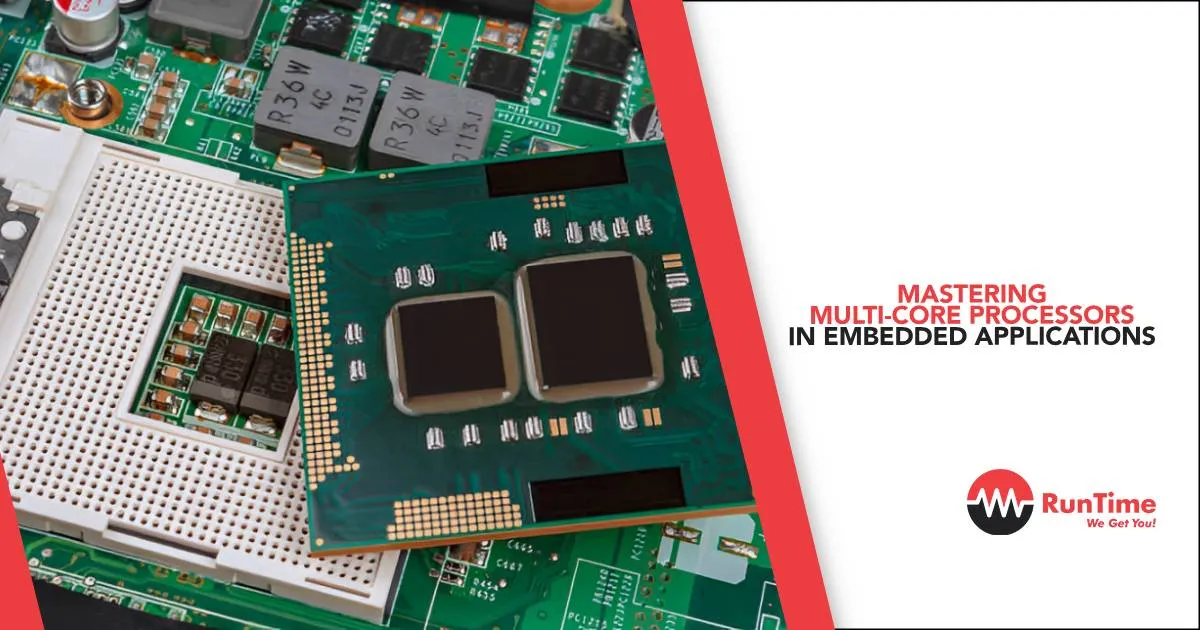Introduction
As embedded systems become increasingly complex and demanding, the need for more powerful and efficient processing solutions has grown. Multi-core processors, which integrate multiple processing units (cores) on a single chip, have emerged as a key technology to meet these demands.
By enabling parallel processing, multi-core processors can significantly enhance the performance, responsiveness, and efficiency of embedded applications. However, mastering multi-core processors in embedded applications presents unique challenges, including task partitioning, inter-core communication, and synchronization.
This article explores the key considerations, tips, and best practices for effectively utilizing multi-core processors in embedded systems. By understanding and addressing these challenges, embedded engineers can unlock the full potential of multi-core processors and create high-performing, scalable, and reliable embedded applications.
Understanding Multi-Core Processors in Embedded Systems
What are Multi-Core Processors?
Multi-core processors are integrated circuits that contain two or more independent processing units (cores) on a single chip. Each core can execute instructions independently, allowing for parallel processing and improved performance. Multi-core processors are commonly used in embedded systems to handle complex tasks, such as real-time data processing, multimedia rendering, and control algorithms.
Key Benefits of Multi-Core Processors
- Enhanced Performance: By distributing tasks across multiple cores, multi-core processors can achieve higher throughput and faster execution times compared to single-core processors.
- Improved Responsiveness: Multi-core processors can handle multiple tasks simultaneously, improving the responsiveness of embedded systems, especially in real-time applications.
- Energy Efficiency: Multi-core processors can optimize power consumption by dynamically adjusting the number of active cores and their operating frequencies based on workload demands.
- Scalability: Multi-core processors provide a scalable solution for embedded systems, allowing engineers to add more cores to meet increasing performance requirements.
Challenges in Mastering Multi-Core Processors
1. Task Partitioning and Load Balancing
Effectively partitioning tasks and balancing the load across multiple cores is a critical challenge in multi-core processor design. Poor task partitioning can lead to underutilized cores, bottlenecks, and reduced system performance.
2. Inter-Core Communication
Efficient communication between cores is essential for coordinating tasks and sharing data. However, inter-core communication can introduce latency, contention, and synchronization issues, impacting overall system performance.
3. Synchronization and Concurrency
Ensuring proper synchronization and managing concurrency are key challenges in multi-core systems. Race conditions, deadlocks, and resource contention can arise if synchronization mechanisms are not implemented correctly.
4. Debugging and Testing
Debugging and testing multi-core systems can be more complex than single-core systems due to the increased complexity of interactions between cores. Identifying and resolving issues such as race conditions and deadlocks requires specialized tools and techniques.
Tips and Best Practices for Mastering Multi-Core Processors
1. Effective Task Partitioning and Load Balancing
To achieve optimal performance, it is essential to partition tasks effectively and balance the load across multiple cores. Consider the following strategies:
- Task Decomposition: Break down complex tasks into smaller, independent sub-tasks that can be executed in parallel. Use techniques such as functional decomposition or data parallelism to identify opportunities for parallel processing.
- Load Balancing: Distribute tasks evenly across cores to avoid underutilization and bottlenecks. Use dynamic load balancing algorithms that adjust task allocation based on real-time workload and core utilization.
- Task Affinity: Assign tasks to specific cores based on their characteristics and requirements. For example, assign real-time tasks to dedicated cores to ensure timely execution and minimize latency.
2. Efficient Inter-Core Communication
Efficient inter-core communication is critical for coordinating tasks and sharing data in multi-core systems. Consider the following strategies:
- Shared Memory: Use shared memory for inter-core communication, allowing cores to access and modify common data structures. Implement proper synchronization mechanisms, such as locks or semaphores, to prevent data corruption and race conditions.
- Message Passing: Use message-passing mechanisms, such as mailboxes or message queues, for inter-core communication. Message passing can reduce contention and improve scalability by decoupling cores and minimizing shared state.
- Hardware Support: Leverage hardware features, such as hardware mailboxes or inter-processor interrupts (IPIs), to facilitate efficient inter-core communication. These features can reduce software overhead and improve communication performance.
3. Proper Synchronization and Concurrency Management
Ensuring proper synchronization and managing concurrency are essential for avoiding race conditions, deadlocks, and resource contention. Consider the following strategies:
- Locks and Semaphores: Use locks and semaphores to protect shared resources and ensure mutual exclusion. Implement fine-grained locking to minimize contention and improve parallelism.
- Atomic Operations: Use atomic operations, such as compare-and-swap (CAS) or test-and-set (TAS), to perform simple, thread-safe updates to shared variables. Atomic operations can reduce the need for locks and improve performance.
- Barriers and Synchronization Points: Use barriers and synchronization points to coordinate the execution of tasks across multiple cores. Barriers ensure that all cores reach a specific point in the code before proceeding, preventing race conditions and ensuring consistency.
- Deadlock Prevention: Implement deadlock prevention techniques, such as resource ordering or timeout mechanisms, to avoid deadlocks. Ensure that all cores acquire resources in a consistent order to prevent circular waits.
4. Debugging and Testing Multi-Core Systems
Debugging and testing multi-core systems require specialized tools and techniques to identify and resolve issues. Consider the following strategies:
- Multi-Core Debugging Tools: Use multi-core debugging tools that provide visibility into the execution of tasks across multiple cores. These tools can help identify issues such as race conditions, deadlocks, and performance bottlenecks.
- Static Analysis: Use static analysis tools to detect potential concurrency issues, such as data races or deadlocks, during the development phase. Static analysis can help identify issues early and reduce debugging effort.
- Dynamic Analysis: Use dynamic analysis tools, such as race detectors or memory analyzers, to monitor the runtime behavior of multi-core systems. Dynamic analysis can help identify issues that may not be apparent during static analysis.
- Stress Testing: Conduct stress testing to evaluate the performance and stability of multi-core systems under heavy workloads. Stress testing can help identify performance bottlenecks and ensure that the system can handle peak loads.
5. Leveraging Hardware Features and Optimizations
Modern multi-core processors offer a range of hardware features and optimizations that can enhance performance and efficiency. Consider the following strategies:
- Cache Coherency: Understand and leverage cache coherency mechanisms to ensure that all cores have a consistent view of shared data. Use cache-aware algorithms and data structures to minimize cache misses and improve performance.
- Power Management: Use power management features, such as dynamic voltage and frequency scaling (DVFS) or core parking, to optimize energy consumption. Adjust the operating frequency and voltage of cores based on workload demands to balance performance and power efficiency.
- Hardware Accelerators: Leverage hardware accelerators, such as DSPs or GPUs, to offload computationally intensive tasks from the main cores. Hardware accelerators can improve performance and reduce the load on the main processing cores.
- Multi-Core Architectures: Understand the architecture of the multi-core processor, including the number of cores, cache hierarchy, and memory organization. Optimize the firmware to take advantage of the specific features and capabilities of the processor.
6. Continuous Learning and Skill Development
Mastering multi-core processors requires continuous learning and skill development. Stay informed about the latest advancements in multi-core technology, tools, and best practices. Participate in training programs, workshops, and online courses to deepen your understanding and stay competitive in the field.
Conclusion
Mastering multi-core processors in embedded applications is a complex but rewarding endeavor. By effectively partitioning tasks, optimizing inter-core communication, ensuring proper synchronization, and leveraging hardware features, embedded engineers can unlock the full potential of multi-core processors and create high-performing, scalable, and reliable embedded systems.
Debugging and testing multi-core systems require specialized tools and techniques to identify and resolve issues, while continuous learning and skill development are essential for staying current with the latest advancements in multi-core technology.
As embedded systems continue to evolve, multi-core processors will play an increasingly important role in meeting the demands of complex and high-performance applications. By mastering the challenges and best practices of multi-core processor design, embedded engineers can position themselves at the forefront of innovation and deliver cutting-edge solutions that drive the future of embedded technology.









